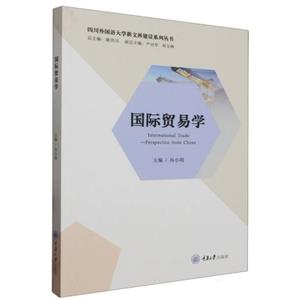Chapter 1 Introduction
1.1 What is international trade?
1.2 Why is international trade important?
1.3 The origin of international trade
1.4 The development of international trade
1.5 The current situation of international trade
1.6 Brief introduction to the course
China-perspective case study
Key concepts
Summary
Exercises
Chapter 2 Basic Concepts
2.1 Statistical indicators
2.2 Basic classifications
China-perspective case study
Key concepts
Summary
Exercises
Chapter 3 The Analysis Tools of International Trade Theories
3.1 Three key questions in international trade
3.2 Production possibility curve
3.3 Community indifference curve
3.4 Budget line and consumer equilibrium
3.5 General equilibrium in isolation and openness
3.6 Isoquant curve
3.7 Isocost line and producer equilibrium
3.8 Supply curve, demand curve and partial equilibrium
3.9 Producer surplus and consumer surplus
3.1 0 Offer curve
China-perspective case study
Key concepts
Summary
Exercises
Chapter 4 Classical Trade Theory
4. ] Mercanti]ism
4.2 Absolute advantage trade theory
4.3 Comparative advantage trade theory
4.4 Empirical tests of the Ricardian model
4.5 Reciprocal demand theory
China-perspective case study
Key concepts
Summary
Exercises
Chapter 5 Neo-classical Trade Theory
5. l Background of neo-classical trade theory
5.2 Heckscher-Ohlin theory
5.3 Factor-price equalization theorem
5.4 Stolper-Samuelson theorem
5.5 Specific-factors model
5.6 Empirical tests of H-O model
China-perspective case study
Key concepts
Summary
Exercises
Chapter 6 New Trade Theory
6.1 Background of new trade theory
6.2 Development of new trade theory
6.3 Intra-industry trade
6.4 Economies of scale and international trade
6.5 Trade based on dynamic technological differences
6.6 The overlapping demand theory
6.7 Trade based on different tastes
6.8 Costs of transportation and environmental standards
China-perspective case study
Key concepts
Summary
Exercises
Chapter 7 Economic Growth and International Trade
7.1 What is economic growth?
7.2 Trade effect of economic growth
7.3 Growth and trade: the small-country case
7.4 Growth and trade: the large-country case
7.5 Growth and trade in both nations
China-perspective case study
Key concepts
Summary
Exercises
Chapter 8 Trade Restrictions: Tariffs
8.1 What is a tariff?
8.2 Nominal tariff and effective protection rate
8.3 Costs and benefits of a tariff
8.4 Partial equilibrium effect of a tariff
8.5 The optimum tariff
China-perspeetive ease study
Key concepts
Summary
Exercises
Chapter 9 Non-tariff Trade Barriers
9.1 Import quotas
9.2 Export subsidies
9.3 Voluntary export restraints
9.4 Dumping and anti-dumping
9.5 Local content requirements
9.6 Technical, administrative, and other regulations
9.7 The infant industry argument
China-perspective case study
Key concepts
Summary
Exercises
Chapter 10 International Integration
10.1 Main forms of regional economic integration
10.2 The development of regional economic integration
10.3 Trade-creating customs union theory
10.4 Trade-diverting customs union theory
10.5 The dynamic effect of customs union
China-perspective case study
Key concepts
Summary
Exercises
Further Readings














